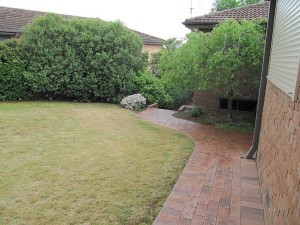IT is vitally important, with unprecedented high fire risks and increasing temperatures, to look closely at your garden.
As we have already experienced in Canberra, one does not necessarily need to live in a bushfire-prone area; fire and ember attack can leap boundaries into urban areas.
Research into the aftermath of the 2003 Canberra fires by Phil Cheney, of the CSIRO, showed that the type of garden plantings played a major part in why some houses survived and others burnt.

This home was saved due to the lawn between the home and shrubs.
Likewise, accumulated debris, particularly from eucalyptus trees in your garden or even if in a nearby park or a neighbour’s garden that fall into your garden, could increase the risk of fire.
Large conifers, with their highly flammable resins, should be avoided .
IT is vitally important not to have native plants close to the house, especially near flammable walls and windows. This includes the garage, shed and even flammable material against timber paling fences.
I am not against native plants, and have used them in many gardens I have designed. However, exotic plants with their glossy green leaves provide a low fire risk.
Immediately after the Canberra fires, I saw that hedges of Viburnum and Photinia did not burn. They were certainly singed badly by the fire and yet, within weeks, were re-shooting.
I visited dozens of fire-affected gardens and saw instances where this type of planting actually saved the house. In the 2009 Black Saturday bushfires it was noted that exotic trees such as oaks, elms and ashes did not ignite and burn.
Lawns can also play a vital part in the survival of houses where they were between the building and shrub beds. Incidentally, artificial grass may not burn, but it can melt, possibly giving off noxious fumes from the burning rubber and synthetic grass blades. If you decide to stay to fight a fire approaching your house, the last thing you want is to be overcome by these fumes.
FOR everyone in a fire-prone area, that means everyone in Canberra and Queanbeyan, I recommend “Essential Bushfire Safety Tips” (CSIRO Publishing), a small but vitally important paperback by one of the foremost authorities on bushfires, Joan Webster, with a foreword by Cheney.
It is concise and straightforward. This latest edition, updated after the 2009 fires, is available from the Australian National Botanic Gardens bookshop and, at $29.95, could be one of the cheapest insurance policies you have ever bought.
MANY people who request the removal of trees that could present a fire threat to their house can face enormous opposition from government, especially in heritage areas.
It is time we looked at this realistically. I have had battles to remove pine trees close to clients’ houses and equally to remove eucalypts in heritage areas. At times, it has taken several appeals before removal was permitted. I am not suggesting the wholesale destruction of trees, but reality must prevail and obviously each case has to be assessed.
LIKEWISE, there must be an increase in funding for pruning, in particular of eucalyptus trees with substantial dead branches.
Numerous roads have what I term “ribbons of fire” with Antill Street as a prime example (pictured at top). Or the parkland extension of Stirling Street, in Watson, with the massed planting of eucalyptus directly behind houses. Maybe it’s time to call a halt for expenditure at the Arboretum to look after the 600,000 urban trees, many in an ever increasing declining state.
Open gardens in Yass
THE Red Cross Open Gardens, part of the Yass Classic Festival, will be held, 10am-4pm, on Sunday, November 3. Entry $10 to all three gardens, which include the historic “Old Linton” gardens in Yass, plus two country gardens. I will be there to answer garden queries. The Yass Tourist Centre can help with the garden locations and a program of festival events or go to classicyass.com
Friends with plants
GROWING Friends Spring Sale, a major fundraising event of the Friends of the Australian Botanic Gardens, is on Saturday, November 9, 8.30am-11am unless sold out sooner. All plants are grown by the Friends from material sourced from the Gardens. All plants are sold for either $3 or $5. Be early and don’t forget to bring your own boxes and bags. Full plant list can be viewed at friendsanbg.org.au
The post How gardens can fight fire appeared first on Canberra CityNews.